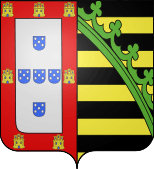Maria II of Portugal
Dona Maria II (4 April 1819 – 15 November 1853) "the Educator" (Portuguese: "a Educadora") or "the Good Mother" (Portuguese: "a Boa Mãe"), was Queen regnant of the Kingdom of Portugal and the Algarves from 1826 to 1828, and again from 1834 to 1853. Born in Rio de Janeiro, she was the first child of Emperor Pedro I of Brazil and his first wife, Empress Maria Leopoldina and thus a member of the House of Braganza. One of the two surviving children born when Pedro was still Prince Royal of the United Kingdom of Portugal, Brazil and the Algarves, she inherited Portuguese titles and was placed in the line of succession to the former Portuguese throne, even after becoming a member of the Brazilian Imperial Family, from which she was excluded in 1835 after her definitive ascension to the Portuguese throne.
Early life
Birth
Maria II was born Maria da Glória Joana Carlota Leopoldina da Cruz Francisca Xavier de Paula Isidora Micaela Gabriela Rafaela Gonzaga[1] at 4 April 1819 in the Palace of São Cristóvão in Rio de Janeiro, Kingdom of Brazil. She was the eldest daughter of the Prince Pedro de Alcântara, future King of Portugal as Pedro IV and first Emperor of Brazil as Pedro I, and his first wife Maria Leopoldina (née Archduchess Caroline Josepha Leopoldine of Austria), herself a daughter of Francis II, Holy Roman Emperor. She was titled Princess of Beira upon her birth. Born in Brazil, Maria was the only European monarch to have been born outside of Europe, though she was still born in Portuguese territory.
Succession crisis
The death of Maria's grandfather, King João VI, in March 1826 sparked a succession crisis in Portugal. The king had a male heir, Pedro, but Pedro had proclaimed the independence of Brazil in 1822 with himself as Emperor. The late king also had a younger son, Miguel, but he was exiled to Austria after leading a number of revolutions against his father and his liberal regime.
Before his death, the king had nominated his favourite daughter, Isabel Maria, to serve as regent until "the legitimate heir returned to the kingdom" — but he had failed to specify which of his sons was the legitimate heir: Pedro, the liberal Emperor of Brazil, or Miguel, the absolutist exiled prince.
Most people considered Pedro to be the legitimate heir, but Brazil did not want him to unite Portugal and Brazil's thrones again. Aware that his brother's supporters were ready to bring Miguel back and put him on the throne, Pedro decided for a more consensual option: he would renounce his claim to the Portuguese throne in favour of his daughter Maria (who was only seven years old), and that she was to marry her uncle Miguel, who would accept the liberal constitution and act as a regent until his niece reached majority.
Miguel pretended to accept, but upon his arrival in Portugal he immediately deposed Maria and proclaimed himself king, abrogating the liberal constitution in the process. During his reign of terror, Maria traveled to many European courts, including her maternal grandfather's in Vienna, as well as London and Paris.
Absolutist uprising

Maria's first reign was interrupted by the absolutist uprising led by her uncle, fiancé and regent Miguel, who proclaimed himself King of Portugal on June 23, 1828. Then began the Liberal Wars that lasted until 1834, the year in which Maria was restored to the throne and Miguel exiled to Germany.
The Marquis of Barbacena, arriving in Gibraltar with the princess on 3 September 1828, was informed by an emissary of what was happening in Portugal. He had the foresight to understand that Miguel had come from Vienna determined to put himself at the head of the absolutist movement, advised by Prince Klemens von Metternich, who was directing European politics, and so it was dangerous for the young Queen to go to Vienna. Taking responsibility, he changed the direction of the journey, and departed for London, where he arrived on 7 October. English policy was not conducive to its purpose. The Duke of Wellington's office openly sponsored Miguel, so the asylum the Marquis had sought was not safe. Maria II was received in court with the honors due to her high hierarchy, but the British prevented their subjects there emigres to go to reinforce the garrison of the island Terceira.
Miguel's coup d'état had not gone unrevealed. On 16 May 1828, the garrison of Porto revolted, and in Lagos an infantry battalion. The revolts were stifled. Saldanha, Palmela, and others, who had come to take charge of the movement in Porto, re-embarked on Belfast ship, which had brought them; the Porto garrison, reinforced by the academic volunteers of Coimbra and other liberal troops, emigrated to Galiza and from there to England. At the head of a small liberal expedition, the Marquis of Saldanha attempted to disembark in Terceira, Azores, but was not allowed to take the English cruise, whose vigilance he could not avoid for some time after the Count of Vila Flor, later of Terceira, was able to disembark. In time, because in August 1829 appeared in front of the island a huge Miguelist squad that sent to soil a body of disembarkation. Then there was the Battle of August 11 in the village of Praia, where the miguelists were defeated. When the emigrants in England received the news of the victory, they felt great enthusiasm. They soon lost hope of knowing that the young queen was returning to the Brazilian Empire to her father. In fact, the situation of Maria II in the English court, next to the ministry in the power, became embarrassing and humiliating. The Queen left London to meet her future stepmother, Amélie of Leuchtenberg. They left together on 30 August 1829 for Rio de Janeiro, arriving on 16 October.
The constitutional cause was thought to have been lost. The dispersed emigres (France, England and Brazil) were divided into rival factions. Only Terceira Island recognized the constitutional principles, and even there appeared miguelists guerillas. France was ready to recognize Miguel's government when the revolution of July broke out in Paris in 1830, which encouraged the Portuguese liberals.
Civil War

In 7 April 1831, Pedro I abdicated the imperial crown of Brazil on behalf of his son Pedro II, Maria's younger brother, and came to Europe with his daughter and his second wife, to support his daughter's rights to the crown from Portugal and joined the forces loyal to Maria in the Azores in their war against Miguel. He took the title of Duke of Braganza, and Regent in her name.
Almost at the same time the regency of the Ilha Terceira, named by Pedro and composed of the Marquis of Palmela, the Count of Vila Flor and José António Guerreiro, prepared an expedition that soon took possession of the Azores. While extending the constitutional territory, Pedro disembarked in France, being welcomed with sympathy by the new government and by Louis Philippe I. Miguel's government had defied the immunities of French subjects, had not at once satisfied the complaints of the French government, which had sent a squadron commanded by Admiral Roussin to force the bar of Lisbon and impose humiliating conditions of peace.
Pedro left his daughter in Paris to finish her education, delivered to her stepmother, Empress Amélie, with good masters, and left for the Azores at the head of an expedition organized on the island of Belle Isle, bringing his supporters together. Arriving in the Azores on 3 March, 1832, he formed a new ministry, assembled a small army, whose command he gave to the Count of Vila Flor, and carried him aboard a squadron which he delivered to the English officer Sartorius, and departed for mainland Portugal. July 8 at Memória Beach in Matosinhos. It was followed by the Siege of Porto and a series of battles until, on 24 July 1833, the Duke of Terceira entered victorious in Lisbon, having won the Battle of Cova da Piedade the day before. Porto and Lisbon, the main cities, were in the power of the liberals. Pedro came to Lisbon, and summoned his daughter from Paris, forcing his brother, Miguel to abdicate in 1834. Maria was thereupon restored to the throne, and obtained an annulment of her betrothal. Soon after her restoration to the throne, her father died from tuberculosis.
On 7 February 1833, in order to protect the Queen, the 2nd Lancers Regiment was created, first known as the Regimento de Lanceiros da Rainha (Queen's Lancers Regiment), with the motto Morte ou Glória, "Death or Glory" (the same as the 17th Lancers, since Lt. Col. Sir Anthony Bacon was its first commander), a fortunate coincidence since the queen's name was Maria da Glória.
Occupying the Portuguese throne, Maria II was still heir presumptive to her brother Pedro II as Princess Imperial of Brazil, until her exclusion from the Brazilian line of succession by law no. 91 of 30 October 1835.
Consolidation
Reign
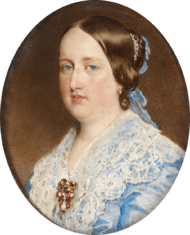
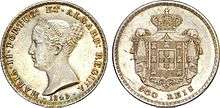
Maria married Auguste, Duke of Leuchtenberg, son of Eugène de Beauharnais, and grandson of Empress Josephine on 26 January 1835, at the age of fifteen. However, he died only two months later, on 28 March 1835.
On 9 April 1836, she married the cultured and able Prince Ferdinand of Saxe-Coburg and Gotha. In accordance with Portuguese law, Ferdinand received the title of king upon the birth of their first child and heir, Peter.
In 1842, Pope Gregory XVI presented Maria with a Golden Rose.
Maria's reign saw a revolutionary insurrection on 16 May 1846, but this was crushed by royalist troops on 22 February 1847, and Portugal otherwise avoided the European Revolution of 1848. Maria's reign was also notable for a public health act aimed at curbing the spread of cholera throughout the country. She also pursued policies aimed at raising the levels of education throughout the country.
Death
.png)
From her first pregnancy, at the age of eighteen, Maria II faced problems in giving birth, with prolonged and extremely difficult labor. An example of this was her third gestation, whose labor lasted 32 hours, after which a girl was baptized in articulo mortis with the name of Maria (1840).
At 25 years of age and in her fifth gestation, the sovereign became obese and her births became even more complicated. In 1847 the fetal distress that preceded the birth of her eighth son – the Infante Augusto, Duke of Coimbra – brought to the world a child "quite purple and with little breathing".
The dangerous routine of successive pregnancies, coupled with obesity (which eventually caused her heart problems) and the frequency of dystocic births (worrisome, especially as a multiparous woman) led doctors to warn the queen about the serious risks she would face in future pregnancies. Indifferent to the warnings, Maria II merely replied: "If I die, I die at my post."
On 15 November 1853, thirteen hours after the onset of labor of the stillborn infant Eugenio, her 11th son, Maria II died at the age of 34. The announcement of death was published in the Government Gazette of November 16, 1853:
Paço das Necessidades, November 15, 1853, at half an hour after noon.
Her Majesty the Queen began to notice announcements of childbirth at nine-thirty on the night of the day. Difficulties appeared in the progress of the same childbirth, which forced the doctors to resort to operations, for which the extraction of an infant was obtained, of time, which received the baptism before being extracted.
The result of these operations took place at ten o'clock in the morning. Unfortunately, after an hour and a half, Her Majesty, exhausted from all strength, declared "I surrender my soul to God after having received all the sacraments."
In a letter dated November 28, 1853, the Duchess of Ficalho, the queen's maid, reported the outcome to her brother, the 2nd Earl of Lavradio:
At two o'clock after midnight from the 14th to the 15th, I was ordered to go to the Palace, where I arrived at about three o'clock. I found the Empress in the Queen's room, where I immediately entered, thinking Her Majesty troubled and even little then we left the immediate room and asked Teixeira[2] what he thought, telling us: "Your Majesty is going well, but slowly." I did not like it, and it was like that, until Teixeira called the doctors, who were out and who had not seen the Queen, and as soon as they examined her, the horrible operation was decided: the doctors were Teixeira, Farto,[3] Kessler,[4] Elias[5] and Benevides.[6] Kessler immediately dismissed the case as very dangerous. The operation was begun. I climbed onto the bed. On the right side, the Empress, full of tears; the Queen, with no fainting, but with a very bad opinion, and, complaining that she was suffering enough, said in her natural voice: "O Teixeira, if I am in danger, tell me, do not deceive me."
Queen Maria II is remembered as a good mother and a kind person who always acted according to her convictions in her attempt to help her country. She was later given the nickname "The Good Mother."
Marriages and issue
Maria first married Auguste Charles, 2nd Duke of Leuchtenberg, son of Eugène de Beauharnais, grandson of Empress Josephine, who died soon after arriving in Portugal. She then married Ferdinand of Saxe-Coburg and Gotha, son of Prince Ferdinand Georg August of Saxe-Coburg and Gotha and his wife Princess Maria Antonia Koháry de Csábrág.
| Name | Birth | Death | Notes |
|---|---|---|---|
| Auguste de Beauharnais (9 December 1810 – 28 March 1835; married on 1 December 1834) | |||
| Ferdinand of Saxe-Coburg and Gotha (29 October 1816 – 15 December 1885; married on 9 April 1836) | |||
| Pedro V | 16 December 1837 | 11 November 1861 | Succeeded his mother as Peter V, 31st (or, according to some, 32nd) King of Portugal. |
| Luís I | 31 October 1838 | 19 October 1889 | Succeeded his brother, Pedro, as 32nd (or, according to some, 33rd) King of Portugal. |
| Infanta Maria | 4 October 1840 | Stillborn daughter. | |
| Infante João | 16 March 1842 | 27 December 1861 | Duke of Beja |
| Infanta Maria Ana | 21 August 1843 | 5 February 1884 | Married King George of Saxony and was the mother of King Frederick August III of Saxony. |
| Infanta Antónia | 17 February 1845 | 27 December 1913 | Married Leopold, Prince of Hohenzollern and was the mother of King Ferdinand I of Romania. |
| Infante Fernando of Portugal | 23 July 1846 | 6 November 1861 | Died of cholera at age 15. |
| Infante Augusto | 4 November 1847 | 26 September 1889 | Duke of Coimbra |
| Infante Leopoldo | 7 May 1849 | Stillborn son. | |
| Infanta Maria da Glória | 3 February 1851 | Died some hours after her birth. | |
| Infante Eugénio | 15 November 1853 | Died some hours after the death of his mother. | |
Titles, styles and honours
| Royal styles of Queen Maria II of Portugal | |
|---|---|
.png) | |
| Reference style | Her Most Faithful Majesty |
| Spoken style | Your Most Faithful Majesty |
| Alternative style | Ma'am |
Titles and styles
- 4 April 1819 – 6 March 1821: Her Royal Highness The Princess of Beira, Duchess of Barcelos
- 6 March 1821 – 4 February 1822: Her Royal Highness Infanta Maria da Glória of Portugal
- 4 February 1822 – 12 October 1822: Her Royal Highness The Princess of Beira, Duchess of Barcelos
- 12 October 1822 – 2 December 1825: Her Imperial and Royal Highness The Princess Imperial of Brazil
- 2 December 1825 – 2 May 1826: Her Imperial and Royal Highness The Princess of Grão-Pará
- 2 May 1826 – 23 June 1828: Her Most Faithful Majesty The Queen of Portugal and the Algarves
- 23 June 1828 – 26 May 1834: Her Most Faithful Majesty Queen Maria II of Portugal
- 7 April 1831 – 30 October 1835: Her Imperial Highness The Princess Imperial of Brazil
- 26 May 1834 – 15 November 1853: Her Most Faithful Majesty The Queen of Portugal and the Algarves
Honours
National honours
She was Sovereign of the following orders:
.svg.png)
.svg.png)
.svg.png)
.svg.png)
.svg.png)
.svg.png)
Foreign
.svg.png)
.svg.png)
.svg.png)
Ancestry
| Ancestors of Maria II of Portugal | ||||||||||||||||||||||||||||||||||||||||||||||||||||||||||||||||||||||||||||||||||||||||||||||||||||||||||||||||||||||||||||||||||||||||||||||||||||||||||||||||||||||||||||||||||||||||||||||||||||||||||||||||||||||||||||||||||||||||||||||||||||||||||||||||||||||||||||||||||||||||||||||||||||||||||||||||||||||||||||||||||||||||||||||||||||||||||||||||||||||||||||||||||||||||||||||||||||||||||||||||||||||||||||||||||||||||||||||||||||||||||||||||||||||||||||||||||||||||||||||||||||||||||||||||||||||||||||||||||||||||||||||||||||||||||||||||||||||||||||||||||||||||||||||||||||||||||||||||
|---|---|---|---|---|---|---|---|---|---|---|---|---|---|---|---|---|---|---|---|---|---|---|---|---|---|---|---|---|---|---|---|---|---|---|---|---|---|---|---|---|---|---|---|---|---|---|---|---|---|---|---|---|---|---|---|---|---|---|---|---|---|---|---|---|---|---|---|---|---|---|---|---|---|---|---|---|---|---|---|---|---|---|---|---|---|---|---|---|---|---|---|---|---|---|---|---|---|---|---|---|---|---|---|---|---|---|---|---|---|---|---|---|---|---|---|---|---|---|---|---|---|---|---|---|---|---|---|---|---|---|---|---|---|---|---|---|---|---|---|---|---|---|---|---|---|---|---|---|---|---|---|---|---|---|---|---|---|---|---|---|---|---|---|---|---|---|---|---|---|---|---|---|---|---|---|---|---|---|---|---|---|---|---|---|---|---|---|---|---|---|---|---|---|---|---|---|---|---|---|---|---|---|---|---|---|---|---|---|---|---|---|---|---|---|---|---|---|---|---|---|---|---|---|---|---|---|---|---|---|---|---|---|---|---|---|---|---|---|---|---|---|---|---|---|---|---|---|---|---|---|---|---|---|---|---|---|---|---|---|---|---|---|---|---|---|---|---|---|---|---|---|---|---|---|---|---|---|---|---|---|---|---|---|---|---|---|---|---|---|---|---|---|---|---|---|---|---|---|---|---|---|---|---|---|---|---|---|---|---|---|---|---|---|---|---|---|---|---|---|---|---|---|---|---|---|---|---|---|---|---|---|---|---|---|---|---|---|---|---|---|---|---|---|---|---|---|---|---|---|---|---|---|---|---|---|---|---|---|---|---|---|---|---|---|---|---|---|---|---|---|---|---|---|---|---|---|---|---|---|---|---|---|---|---|---|---|---|---|---|---|---|---|---|---|---|---|---|---|---|---|---|---|---|---|---|---|---|---|---|---|---|---|---|---|---|---|---|---|---|---|---|---|---|---|---|---|---|---|---|---|---|---|---|---|---|---|---|---|---|---|---|---|---|---|---|---|---|---|---|---|---|---|---|---|---|---|---|---|---|---|---|---|---|---|---|---|---|---|---|---|---|---|---|---|---|---|---|---|---|---|---|---|---|---|---|---|---|---|---|---|---|---|---|---|---|---|---|---|---|---|---|---|---|---|---|---|---|---|---|---|---|---|---|---|---|---|---|---|---|---|---|---|---|---|---|---|---|---|---|---|---|---|---|---|---|---|---|---|---|---|---|---|---|---|---|---|---|---|---|---|---|---|---|---|---|---|---|---|---|---|---|---|---|---|---|---|---|---|---|---|---|---|---|---|---|---|---|---|---|---|---|---|---|---|---|---|---|---|---|---|---|---|
| ||||||||||||||||||||||||||||||||||||||||||||||||||||||||||||||||||||||||||||||||||||||||||||||||||||||||||||||||||||||||||||||||||||||||||||||||||||||||||||||||||||||||||||||||||||||||||||||||||||||||||||||||||||||||||||||||||||||||||||||||||||||||||||||||||||||||||||||||||||||||||||||||||||||||||||||||||||||||||||||||||||||||||||||||||||||||||||||||||||||||||||||||||||||||||||||||||||||||||||||||||||||||||||||||||||||||||||||||||||||||||||||||||||||||||||||||||||||||||||||||||||||||||||||||||||||||||||||||||||||||||||||||||||||||||||||||||||||||||||||||||||||||||||||||||||||||||||||||
In Literature
| Wikisource has original text related to this article: |
In 1832, Letitia Elizabeth Landon published The Queen of Portugal, a poem protesting at her banishment and offering sympathy and hope for a peaceful restoration.
See also
| Wikimedia Commons has media related to Maria II of Portugal. |
Footnotes
- ↑ Sousa 1972a, p. 112.
- ↑ Manuel Carlos Teixeira, professor of the Medical-Surgical School of Lisbon and 1st private surgeon of the Royal Chamber (1856), dean of the Royal Hospital of S. José – where he served since 1819. He died in March 1877.
- ↑ António Joaquim Farto was a surgeon at the Royal Hospital of St. Joseph (1797), a surgeon who was accorded the honors of the royal surgeon (1827), a nobleman of the Royal House (1827), director of the Medical-Surgical School of Lisbon (1830) and 1st surgeon of the Royal Chamber (1837). He passed away in October 1856.
- ↑ Dr. Friedrich Kessler (1804–1872), Doctor of Medicine and the personal physician to King Fernando II. He was made a partner of the Royal Academy of Sciences of Lisbon and 1st Baron of Kessler (1855).
- ↑ Dr. Francisco Elias Rodrigues da Silveira (1778–1864), bachelor of Philosophy and graduate in Medicine, member of His Most Faithful Majesty's Council, member of the Royal Academy of Sciences of Lisbon, 1st physician of the Royal Chamber, publicist and finally 1st Baron of Silveira (1855).
- ↑ Dr. Inácio António da Fonseca Benevides (1788–1857), a bachelor of medicine (1813), was director of the Royal Academy of Sciences of Lisbon (1817), private physician of the Royal Chamber (1827), physicist of the Royal Navy (1832), chairman of the Naval Health Council, adviser to the Council of His Majesty (1853) and publicist of scientific subjects.
References
- Sousa, Otávio Tarquínio de (1972a). A vida de D. Pedro I (in Portuguese). 1. Rio de Janeiro: José Olympio.
Maria II of Portugal Cadet branch of the House of Aviz Born: 4 April 1819 Died: 15 November 1853 | ||
| Regnal titles | ||
|---|---|---|
| Preceded by Pedro IV |
Queen of Portugal and the Algarves 1826–1828 |
Succeeded by Miguel as usurper |
| Preceded by Miguel as usurper |
Queen of Portugal and the Algarves 1834–1853 with Ferdinand II (1836–1853) |
Succeeded by Pedro V |
| Brazilian royalty | ||
| New title | Princess Imperial of Brazil 12 October 1822 – 2 December 1825 |
Succeeded by Pedro |
| Princess of Grão-Pará 2 December 1825 – 2 May 1826 |
Vacant Title next held by Pedro de Alcântara | |
| Preceded by Prince Pedro |
Princess Imperial of Brazil 7 April 1831 – 30 October 1835 |
Succeeded by Januária Maria |
| Portuguese royalty | ||
| Preceded by Pedro |
Duchess of Braganza 12 October 1822 – 2 May 1826 |
Vacant Title next held by Pedro |
| New title | Duchess of Porto 4 April 1833 – 31 October 1838 |
Succeeded by Luís |
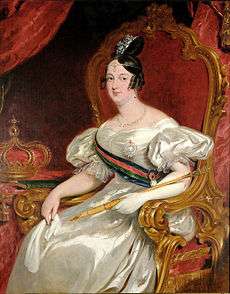
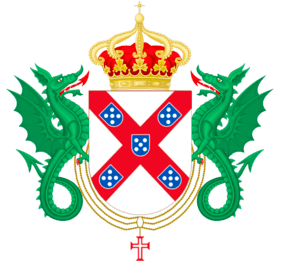
.svg.png)
